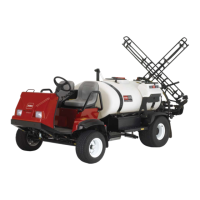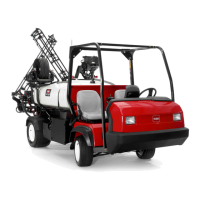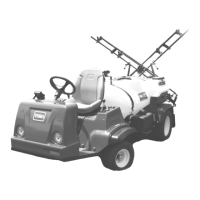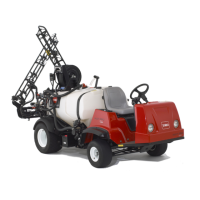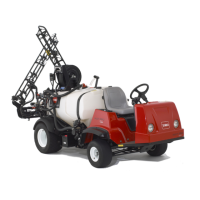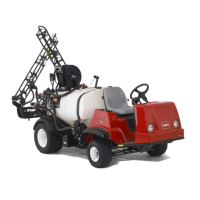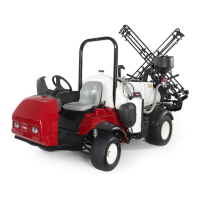Multi Pro 5800Hydraulic System Page 5 − 38
8. After installing tester, start engine and run at low idle
speed. Check for hydraulic leakage and correct before
proceeding with test.
9. Increase engine speed to high idle (Diesel Engine:
3050 to 3150 RPM, Gasoline Engine: 3200 RPM)
NOTE: If engine speed drops below specified RPM,
pump flow will decrease. Adjust test specifications ac-
cordingly (see Testing in this chapter).
10.Make sure hydraulic oil is at normal operating tem-
perature by operating the machine for approximately ten
(10) minutes. Make sure the hydraulic tank is full.
11.Sit in the operator’s seat and release the parking
brake.
12.Verify pump flow at No Load as follows:
A. With the tester is installed in the upper pump port,
slowly depress the traction pedal to full forward posi-
tion.
B. Record tester pressure and flow readings. Unres-
tricted pump output should be approximately 32
GPM (121 LPM).
13. Verify pump flow Under Load as follows:
A. With the tester is installed in the upper pump port,
slowly depress the traction pedal to full forward posi-
tion.
B. Apply an additional load of 1500 to 2000 PSI
(103 to 138 Bar) by slowly closing the flow meter.
C. Record tester pressure and flow readings.
14.Verify traction relief valve operation as follows:
A. Return the traction pedal to neutral.
B. Fully close the flow meter flow control valve.
C. If the tester is installed in the upper pump port,
slowly depress the traction pedal to full forward posi-
tion. If the tester is installed in the lower pump port,
slowly depress the traction pedal to full reverse posi-
tion.
D. Record tester pressure reading.
System pressure should reach 4250 PSI (293 Bar)
before the relief valve opens.
NOTE: The relief valve setting is 4000 PSI (276
Bar). An additional 250 PSI (17 Bar) is necessary to
overcome system charge pressure before the relief
valve opens.
E. Release traction pedal, open flow control valve
fully, move throttle to low speed and turn the engine
off.
15.If relief pressure can not be met or is greater than
specified, inspect traction pump relief valves (Fig. 31)
(see Piston (Traction) Pump Service in this chapter).
Clean or replace valves as necessary. These cartridge
valves are factory set and are not adjustable. If relief
valves are in good condition, traction pump or rear
wheel motors should be suspected of wear and ineffi-
ciency.
16.The Under Load test flow reading (step 13.) should
not drop more than 12% when compared to the No
Load test flow reading (step 12.). A difference of more
than 12% may indicate the traction (piston) pump is
worn and should be repaired or replaced.
17.Disconnect tester and reconnect hose to pump.
18.Start engine and run at low idle speed. Check for hy-
draulic leakage and correct before returning machine to
service.

